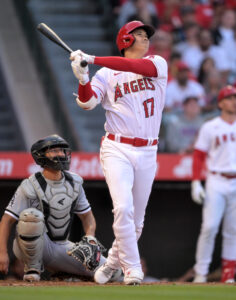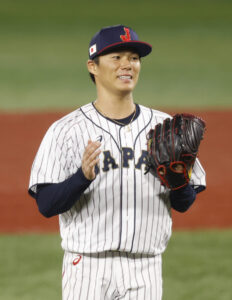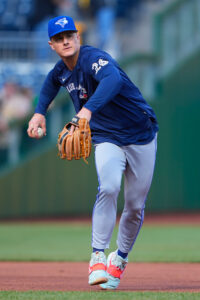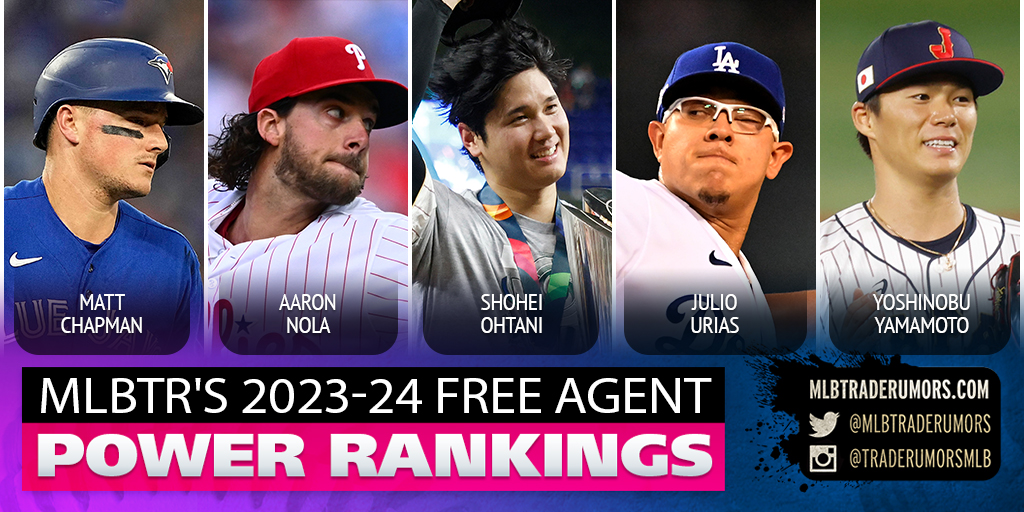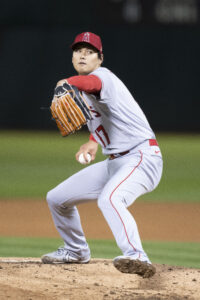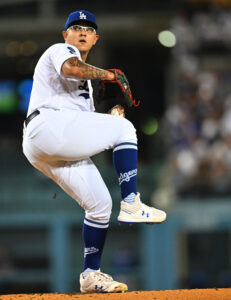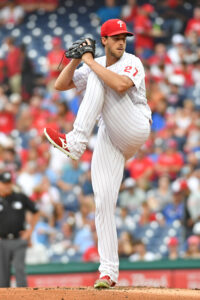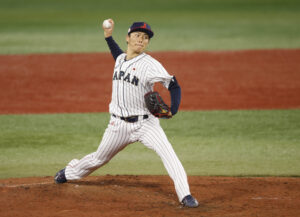The NPB All-Star Game wrapped up this week and the second half of the 2023 season is set to start back up tomorrow. Let’s catch up with the NPB stars who may be making their way to MLB.
For more detailed profiles and playstyles, please take a look at the first post of the series from April!
Players likely available in the 2023 offseason (most rumored or have publicly announced desire to play in MLB)
1. Yoshinobu Yamamoto, Orix Buffaloes
In the last update, I wrote that Yamamoto had his best month of the season. The 24-year-old right-hander has maintained his excellent form through June and through the All-Star break. Outside of a June 23 start against the Fukuoka Softbank Hawks where he gave up four runs in six innings, he’s tossed at least eight innings of one-run ball in each of his last three starts, including a complete game against the Saitama Seibu Lions on July 8.
On the season, Yamamoto has a 1.74 ERA, a solid 28.7 K%, and an impressive 3.3 BB% in 13 starts and 93 ⅓ innings pitched. He’s fourth in the Pacific League in innings despite having three fewer starts than the league leader. He’s issued just one walk in his past four starts, and hitters have a .201 batting average against him. He was a surprise and controversial snub from the initial All-Star ballot, but was eventually voted in through the “Plus One” runoff voting to earn his fifth consecutive All-Star nod.
MLB teams are ramping up their interest in Yamamoto, with scouts of eight teams attending his July 8th start, per Sports Hochi. He also ranks second in MLBTR’s recent 2023 free agency power rankings, and as Steve Adams writes, “A contract in excess of $200MM doesn’t seem outlandish if he can remain healthy and productive.”
2. Shota Imanaga, Yokohama DeNA Baystars
The 29-year-old left-hander has been at his very best since the last update, allowing just three runs in 32 innings in his last four starts — including a one-run, complete game against the Hanshin Tigers on June 23 and a seven-inning, 15-strikeout gem against the Yomiuri Giants on July 7. He finished June with a 1.41 ERA and has a 0.60 ERA thus far in July.
Imanaga’s ERA is down to 2.07, which is fourth among qualified pitchers in the Central League, with a 28.5 K% and a minuscule 2.4 BB% in 12 starts and 87 innings pitched. These stats were good enough for the lefty to get to his second career All-Star nod. Although he is still prone to long balls with 11 homers allowed on the season, he’s otherwise avoided trouble. Imanaga’s chances of coming to MLB are pretty high, as he signed with the U.S.-based agency Octagon to help talks toward a posting agreement last offseason.
3. Yuki Matsui, Tohoku Rakuten Golden Eagles
The 27-year-old left-hander finished the first half with 23 saves, tied for most in NPB. He’s yet to give up a run in eight appearances in July and has been key to the Eagles going 11-3 in the month. The increased workload is a big contrast from NPB updates earlier in the season where Matsui didn’t have as many appearances due to the Eagles’ poor record.
Matsui has a 0.55 ERA in 34 appearances, with a 36.3 K% and a 4.1 BB%. Although he was snubbed from the All-Star Game, Matsui is happy with the rest. “I’m thankful [for the increased workload], it’s my job to close out games and win so it’s a good thing,” Matsui said. Matsui has still not made his plans beyond 2023 clear, but he is definitely a name to keep an eye on for teams that need a lefty for their bullpen.
4. Kona Takahashi, Saitama Seibu Lions
Takahashi has had a rough July on paper, recording a 3.79 ERA in three starts, including two outings lasting just five innings. He’s bounced back from those outings in his most recent start on July 16, tossing a four-hit, six-strikeout, complete game shutout against the Hokkaido Nippon Ham Fighters. It was his first shutout since 2020 and the fourth of his career.
The 26-year-old right-hander’s ERA now sits at 2.25 despite the rough starts in the past few months, with a 19.1 K% and a 6.8 BB% in 16 starts and 108 innings pitched. Takahashi also missed out on the All-Star game despite his strong performance in the first half thanks to a deep pool of quality starters in the Pacific League.
Takahashi’s strikeout rate has dropped in the past few weeks, but increased average fastball velocity and ability to eat innings should still be appealing to MLB teams looking for some starting pitching help.
5. Naoyuki Uwasawa, Hokkaido Nippon Ham Fighters
In the last update, I wrote that Uwasawa was back to his best, and finishing the season closer to a 2.50 ERA would help his chances for an MLB contract this offseason. The 29-year-old right-hander followed up his strong June with solid performances in July, including eight shutout innings against the Lions this past weekend.
His season ERA is down to 2.87 with a 17.3 K% and 7.4 BB%. If you remove his worst start of the season against the Lions on April 15 (where he gave up eight earned runs in 5 ⅓ innings), his ERA goes all the way down to 2.31. It’s quite a remarkable turnaround for Uwasawa considering that his ERA was up to 4.62 on May 6. He is third in the Pacific League with 106 ⅔ innings in 15 starts. Uwasawa received his second career All-Star nod, his first since 2021.
Younger stars to keep an eye on
1. Roki Sasaki, Chiba Lotte Marines
In his last three starts since the last update, Sasaki has allowed just one run in 22 frames while going at least seven innings and fanning at least 10 in every one of those starts. He also matched the record for the fastest NPB pitch at 103 MPH. In his most recent start, where he struck out 14 in seven innings, the average velocity on his fastball was at 99 MPH. There aren’t enough words to describe Sasaki’s dominance in the first half of 2023, as he finished with an NPB-best 1.48 ERA in 12 starts. He had an unfathomable 41 K%, 4.7 BB%, and a.151 opponent batting average in 79 innings pitched. It’s hard to imagine Sasaki can improve on these numbers, but with the combination of his age at 21 and 2023 being just his second full season of work, it’s certainly possible he reaches another level. Sasaki still has room to improve his in-game stamina and has some remaining physical projection.
2. Munetaka Murakami, Tokyo Yakult Swallows
Murakami continues to look more like his Triple Crown-winning self, following up a strong June with a few solid weeks to finish up the first half of the season. He’s slashing .306/.352/.612 with four homers in July. Murakami finished the first half of the season slashing .242/.359/.451 with 16 homers and his OPS is finally above .800 at .809. Despite his horrendous slump to open the season, Murakami still finished the first half in the top three in homers and RBI in the Central League. He’s managed to regain some of his form even though the Swallows are missing key lineup contributors with injuries: including perennial All-Star Tetsuto Yamada and Yasutaka Shiomi, who has been a .800 OPS hitter since 2020. Murakami is still striking out at an alarming 31% rate and has a strong 14.2 BB%. Murakami missed out on the All-Star Game,
3. Kazuma Okamoto, Yomiuri Giants
Although the 27-year-old corner infielder is slashing a .297/.393/.557 with a .950 OPS, 20 homers, and 51 RBIs (all in the three in all categories in the Central League), Okamoto has cooled off significantly in July, slashing just .208/.328/.375. The All-Star break could not have come at a better time for Okamoto, who had just two hits out of 26 plate appearances in his last six games to close the first half. He was the first to reach the 20-homer mark in NPB on July 7, on a solo homer off of Imanaga, but hasn’t added to his tally since. Despite the mini-slump, Okamoto is still on pace for what would be his sixth consecutive 30-homer season.
An interesting note is that he has been mashing lefties this season, slashing .355/.463/.656 in 110 plate appearances. If he is able to continue to mash lefties, the combination of Okamoto’s consistent power numbers, solid defense at the corners (two-time Gold Glove winner), and potential for positional versatility (taking reps at left field this year) should be a compelling package for MLB teams looking to add a right-handed power bat.
Honorable Mentions
The following players have either expressed their desire to play in the big leagues, been rumored by Japanese media, or have drawn interest from MLB scouts but have factors (age, team stance on posting system) preventing a potential move. I’ve also added top performers who may be of interest.
Shosei Togo, right-handed starting pitcher, Yomiuri Giants; Taisei Ohta, right-handed reliever, Yomiuri Giants; Hiroto Takahashi, right-handed starting pitcher, Chunichi Dragons; Kaima Taira, right-handed starting pitcher, Saitama Seibu Lions; Atsuki Yuasa, right-handed reliever, Hanshin Tigers; Shinnosuke Ogasawara, left-handed starting pitcher, Chunichi Dragons; Shunpeita Yamashita, Orix Buffaloes; Atsuki Taneichi, right-handed starter, Chiba Lotte Marines.

